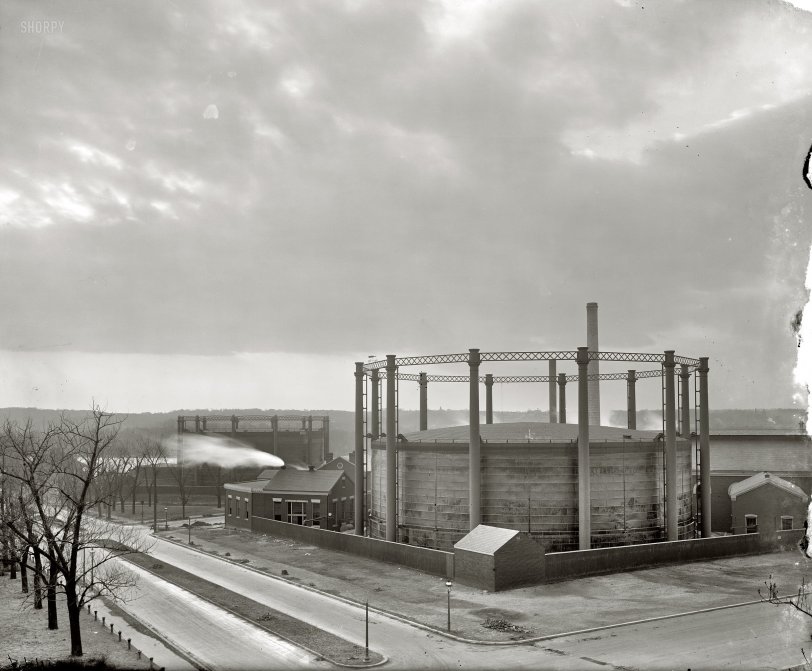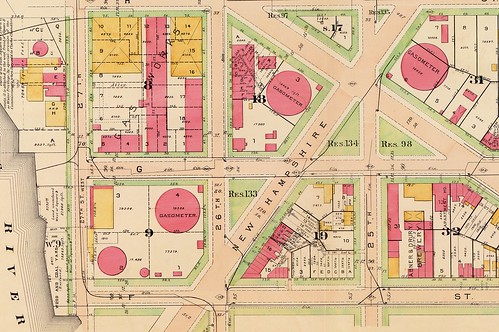


Framed or unframed, desk size to sofa size, printed by us in Arizona and Alabama since 2007. Explore now.
Shorpy is funded by you. Patreon contributors get an ad-free experience.
Learn more.

- Lofty addition
- In 1912
- Keenan Building
- Six years old
- Taken from the P.J. McArdle Roadway?
- It stood only 47 years
- Three track mind
- Incline to the right
- Reach for the sky, 1912 style
- No clean sweep
- Same Job Title, Same Face
- Sadly Lost
- Beautiful ...
- Where you get your kicks
- Aim High
- Pueblo Revival sisters
- Pueblo Neoclassicism
- Milk Man
- Regional dialect.
- Spielberg's inspiration
- Great Photo
- Loaf Story
- Do you still have the Rakes category?
- Could almost be a scene from the 1957 movie 'Hell Drivers'
- The Wages of Fear.
- Conspicuous by their absence
- Got Milk?
- All that aluminum
- No lefties
- Smoke 'em if you've got 'em
Print Emporium
Gaslight: 1917

Washington, D.C., circa 1917. "Washington Gas Light holders at 26th and G streets N.W." These relics of the gaslight era ("two of Washington's biggest stinkers") were scrapped around 1947. Just about every city of any size in the latter half of the 19th century had its "gashouse district" -- a rough neighborhood dominated by smelly holding tanks for the municipal gas plant, where coal was gasified to make "city gas" (generally either "coal gas" or "water gas," depending on the process) for illumination. Harris & Ewing Collection glass negative. View full size.
Snuffed out.
I have actually seen several accounts in 19th Century newspapers of country rubes arriving in the city and staying at a hotel, seeing gas lighting for the first time in their lives and proceeding to blow out the flame at bedtime without turning off the gas jet, despite signs warning not to do so. The poor devils snuffed themselves out.
Gas Poisoning
Coal gas, around 25 percent carbon monoxide by volume, was the cause of frequent accidental poisonings, with lots of articles in the newspapers about people found dead in their beds because someone turned on a gas jet by accident without lighting it. Or maybe not so accidentally -- "taking the gas pipe" was a common method of suicide.
Vienna gasometer
In Europe (I don't know about the U.S.A.) you may even see gas holders covered by a brick building, like this one in Wien-Simmering:

Washington posts
Note the electric streetlamps in the process of being installed. Any day now, those incandescents will be lit up and the gasometers will be supplying several fewer gaslamps.
Gashouse Gables
In the 1927 movie "It," Clara Bow's character lives in a neighborhood called Gashouse Gables. I wondered what the term referred to, now it can be told.
Bugs Bunny played 'em!
In the 1946 Looney Tune "Baseball Bugs," Bugs Bunny plays single-handed against a rough-looking team called the Gashouse Gorillas.
Foreshadowing
Isn't 26th and G NW roughly where the Watergate is now?
Top of the World, Ma!
In "White Heat," there's a gasworks scene with Jimmy Cagney delivering the famous line, "Top of the world, Ma!"
Gasworks built 1852
Based on the Baist real estate map, the tank pictured closest in the photo was located just west of the intersection of Virginia and New Hampshire avenues (the Gasometer labeled 3 on the map). The gas works was located in this part of town to allow for economical delivery of coal (the primary fuel source) to the wharf on the Potomac.
Big Gas Tanks Here Headed for Junkyard
Two of Washington's biggest stinkers - both landmarks of the gas light era - are headed for the junkyard, completely deodorized.
They are the Washington Gas Light Company's huge holders -- or tanks as the public regards them -- at 26th and G sts. nw., and New Hampshire and Virginia aves. nw. The holders, one of which was five years old when the Civil War started, are falling a victim to the gas company's conversion to natural gas.
One of them held 591,000 cubic feet and the other 682,000 cubic feet and both held enough gas to last Washington 15 minutes in a rush period, officials said. Never regarded as a storage unit, but rather as a part of the gas manufacturing equipment, the holders lost their usefulness when the company halted manufacture of gas at the Northwest plant. Only gas made now is at the 12th and N st. ne. plant.
The huge holders, of thin steel, will be dismantled by a junk dealer and the 30-foot deep holes filled in with earth, the company said.
"People don't notice any changes around here," one official observed a little mournfully, "They just notice it smells bad."
Washington Post, Aug 1, 1947
Foggy Bottom Jarred to Heels
Groundbreaking activities for a 8-story cooperative apartment unit of the Potomac Plaza Corporation's Foggy Bottom renewal project started out last week with ground shaking activity.
Morauer & Hartzell, Inc., the Washington excavation firm on the job, have seldom encountered ground packed so hard as the 12-inch concrete base of an old Washington Gas Light Co. tank. A portion of the company's old West Station, the tank became obsolete with the changeover to natural gas. Its base has faithfully resisted deterioration since it was laid in 1852.
...Washington Post, Apr 16, 1956
26th & G St. NW is now...
...the Watergate complex.
The Gas House Gang...
.. was the nickname given to the 1934 St. Louis Cardinals, one of the great teams of all time.
The East Coast press, who for decades before and since felt that the league and Series titles were their birthright, characterized the Cards as being made up of hicks (Pepper Martin), thugs (Joe Medwick) and loudmouths (Dizzy Dean).
That characterization was not totally incorrect, but as Diz said "If ya can do it, it ain't braggin"... and they did it.
There is a great cartoon which some Shorpyite (not behind a net nanny filter at work like me) can probably find and post, showing a group of Neanderthal types in baseball uniforms, walking through a gas tank field with clubs over their shoulders. The caption is simply "The Gas House Gang".
Boston Blackie
The old TV series "Boston Blackie" often had Blackie climbing one of these monsters.
Telescoping Tanks
Yes, the once-common "gasometer" telescopes up and down as the quantity of gas varies. You can see the inner and outer sections in the picture, as well as the guide wheels that roll up and down the support pillars. The gap between was filled with water. Nowadays much smaller pressure tanks fill the need. As the 1911 Encyclopaedia Britannica delicately advised, "A gasworks should be located with care as it does not improve the neighborhood."
Up and Down
Do the tanks go up and down?
I have a picture of some tanks that were always at different heights--they are in the background of some of my dad's family pictures taken in Maryland around 1949.
He said they would rise and fall depending on how full they were.

























On Shorpy:
Today’s Top 5